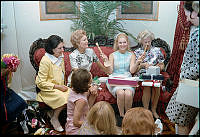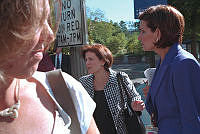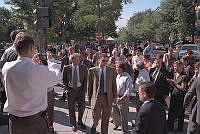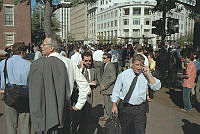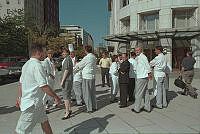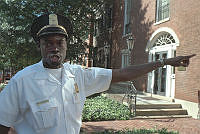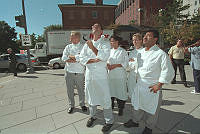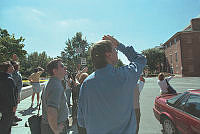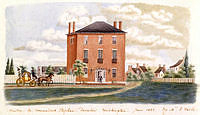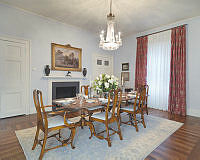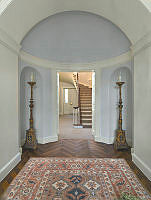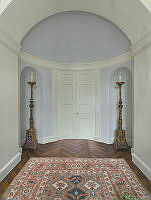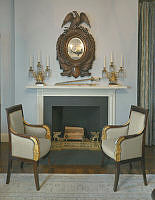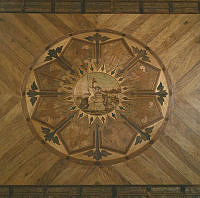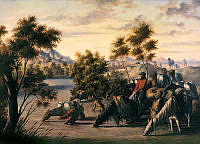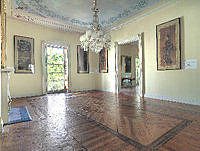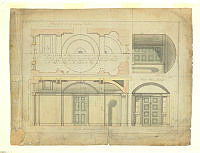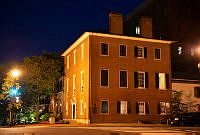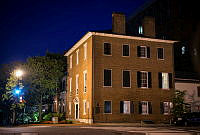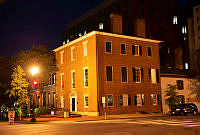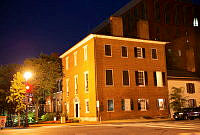Rubenstein Center Scholarship
Murder and Untimely Tragedy: The Haunting of Lafayette Square
Places believed to be "haunted" are often the setting of an assortment of numerous grisly stories. Lafayette Square, the area directly north of the White House, is frequently considered a "ghostly" site. Several gruesome tales contribute to its deservedly spooky reputation.
The most harrowing occurrence is a legendary Washington, D.C. story involving murder, intrigue, lust, and revenge. On February 27, 1859, a killing occurred in broad daylight in Lafayette Square. Representative Daniel Sickles of New York shot United States District Attorney Philip Barton Key. Philip was the son of Francis Scott Key, the author of "The Star-Spangled Banner."

Daniel Sickles murders Philip Barton Key in Lafayette Square in 1859.
Library of CongressSickles and his wife Teresa lived in a home on the west side of the square, now called Jackson Place. Due to the favorable proximity of their house, they frequently hosted parties and other social gatherings, making them a well-known "power couple" in Washington.
Key, a widower, made the acquaintance of Teresa through Congressman Sickles. Philip and Teresa were often seen around town together, although Daniel Sickles seemed not to know about the liaison his wife and friend were engaged in.1
On the night of February 24, 1859, Sickles received an anonymous note about the affair. The informant provided specific details about the illicit relationship, including the fact that Key rented a house on Fifteenth Street where he notified Teresa about visits by hanging a string out the window.2
After an investigation, Mrs. Sickles confessed, in writing, of her infidelity. On February 27, 1859, Congressman Sickles spotted Key outside the house they rented on the west side of Lafayette Square. Key had been circling the square, waving a handkerchief to signal Teresa for a meeting. Samuel Butterworth was at the Sickles house that morning to counsel Sickles concerning the affair. According to eyewitness accounts, Butterworth exited the house and approached Key first, perhaps detaining him as Key walked eastward toward the Washington Club on Madison Place.
In the meantime, Sickles armed himself with a Derringer and Colt revolver. Sickles emerged from the house, crossed the square, and approached Key, reportedly saying, "You villain! You have dishonored my house and you must die!" The first shot missed Key, who attempted to wrestle away from Sickles. However, the next shot hit its mark. Key begged for his life as he fell backwards, but Sickles was undeterred. He shot Key two more times at close range.3 Key was carried by bystanders to the Washington Club, where he died shortly thereafter from his wounds.4
At the trial, Sickles claimed temporary insanity, the first time such a defense had been mounted in a United States court. Edwin Stanton, the future Secretary of War under Abraham Lincoln, served as a lawyer for Sickles. The jury believed the defendant's claims, and after only an hour of deliberation, they acquitted him.5 Sickles fought in the Civil War for the Union, lost a leg at the Battle of Gettysburg, and then became a leading advocate for the establishment of Gettysburg National Military Park.
Interestingly enough, there are accounts of two ghosts in Lafayette Square related to this story. Philip Barton Key supposedly haunts the area, looking for Sickles. There are also stories about the apparition of Daniel Sickles. The loud thumping of his limp is interpreted as an attempt to escape the determined Key, who seeks to avenge his murder from the grave.6
Furthermore, there are at least two ghost stories about Key's spirit and the events surrounding Abraham Lincoln's assassination. According to the National Directory of Haunted Places, Key's ghost allegedly appeared to Secretary of State William Seward in Lafayette Park in 1865 and warned him about an impending assassination attempt on his life.7
In another version of the tale, Key's spirit interrupted the attempted murder of Seward inside the house itself. Key died on the first floor of the house, previously the Washington Club, but purchased by Seward in 1861 as a private home. Key's ghost supposedly made a "loud and unusual" noise that alerted Seward's son and servant, who interrupted conspirator Lewis Powell and saved Seward's life.8 Although an entertaining story, Key's ghost doesn't exactly comport with eyewitness accounts of the infamous assassination attempt. Powell made his presence known almost immediately upon entering Seward's house, misfiring his gun, and clubbing Seward's other son over the head with the weapon.9 Given the commotion, it is unlikely Powell needed Key's ghost to signal his presence.

Commodore Stephen Decatur
Library of CongressSecond only to the Key murder in Lafayette Square is the demise of the famous naval war hero, Commodore Stephen Decatur, Jr. A dashing military officer, Decatur appeared to have the world in the palm of his hand in 1819 when he built the first residential home on what is now Lafayette Square. Along with his wife Susan, Decatur moved into the house designed by Benjamin Latrobe with his eye on advancing his social position and perhaps serving in political office one day.
However, Decatur was drawn into a festering dispute with Commodore James Barron. Decatur had previously sat on the 1808 court-martial that suspended Barron from military service, and then he subsequently declined to support Barron's reinstatement to the Navy in 1818.10 Barron edged Decatur towards a duel, writing a letter stating that Decatur had challenged him to a duel. After some back and forth, Decatur felt as though he could not back down since his honor and reputation were at stake.11
According to a newspaper account, the duel took place on Wednesday, March 22, 1820, in Bladensburg, Maryland. The gunfight took place at eight paces with pistols. Upon first fire, both were wounded. Decatur was hit in the abdomen and died at half past ten in the evening on the same day. Decatur was transported back to his house on Lafayette Square where he died with his wife Susan present inside the house.12 However, Decatur would not let Susan see him; she could only listen to his painful groans from the hallway. He reportedly expired after "lingering in agony."13
Like the previous story, there are two supposed apparitions associated with the death of Stephen Decatur. The first, of course, is the ghost of Stephen Decatur himself. He is seen looking out a second-floor window of Decatur House (now occupied by the White House Historical Association) with a pained look on his face. At other times, his face appears in the first-floor window.14 His likeness has also been reportedly seen walking out of the back door of Decatur House, carrying a pistol.15 The distressing sound of Susan Decatur's weeping and sobbing is sometimes heard inside the house itself or within Lafayette Square, mourning the tragic loss of her husband for all eternity.16

Sculpture at the Rock Creek Cemetery Gravesite of Clover Adams
Library of CongressThe last story of untimely death in Lafayette Square is the tragic tale of Marian "Clover" Adams, who married historian, writer, and presidential descendant Henry Adams in 1872. The couple lived in a house on H Street, now the site of the Hay-Adams Hotel. Much like the Decaturs, they enjoyed a highly privileged socialite status in Washington, D.C. society. Clover became an accomplished amateur photographer, although Henry never allowed her to publish her images professionally.17
Despite the acclaim she received within elite circles for her expressive portrait photography, Clover became depressed after the death of her father. She took her own life in 1885 at the age of forty-two, swallowing the potassium cyanide she used to develop her photographs. Henry Adams was so distraught about his wife's death, he burned the letters she had written to him and never spoke of her again.18 However, Adams did commission famous American artist Augustus Saint-Gaudens to sculpt a Buddhist-inspired bronze memorial to Clover at her gravesite in Rock Creek Cemetery. The brooding sorrow depicted in the androgynous figure is palpable, and it is considered one of the most haunting, eerie pieces of art in Washington, D.C.
Given the tragic nature of her death, it is no surprise that the purported ghost of Clover Adams has surfaced inside the Hay-Adams Hotel, which now occupies the site of the house where she died. The hallways at the hotel allegedly smell like almonds, which is the scent of the potassium cyanide Clover ingested to commit suicide.19 A female spirit is often heard crying in a room or stairwell, particularly in the month of December near the anniversary of Clover's death.20

"Black Aggie" sculpture in the courtyard of the National Courts Complex in Lafayette Square.
Colleen ShoganThe story doesn't end there. A man named Felix Agnus, the publisher of the Baltimore Star, decided he wanted a remarkable gravesite memorial for himself and his family. To this end, he acquired an unauthorized replica of the mournful sculpture at the Clover Adams grave, constructed from a "surreptitious casting" that was made at Rock Creek Cemetery.21
Although Saint-Gaudens' widow protested, Agnus was buried next to the copied sculpture in 1926 at Druid Ridge Cemetery in Pikesville, Maryland. Over the years, the Agnus gravesite sculpture became known as "Black Aggie" due to its pernicious reputation. Its eyes reportedly glowed red at night, and its powers could cause untimely death and even miscarriages in pregnant women. Eventually, due to the disruptions in the cemetery that "Black Aggie" caused, the Agnus family donated the statue to the Smithsonian, who then transferred it to the General Services Administration (GSA). There was initial interest in placing the figure in the courtyard of Blair House on Lafayette Square. However, the Garden Committee at Blair House decided there was not enough room in the garden to accommodate the sculpture.22
In 1988, the GSA placed the statue in the rear courtyard of the National Courts Building on Lafayette Square, previously the Cutts-Madison House. The statue now is located only steps away from where Clover Adams tragically ended her life.23
Ghost stories are centered around true histories of calamity, woe, murder, and untimely death. Lafayette Square is home to many harrowing tales of loss and sorrow. It is no surprise, then, that Lafayette Square is one of the most haunted sites in our nation's capital city.













